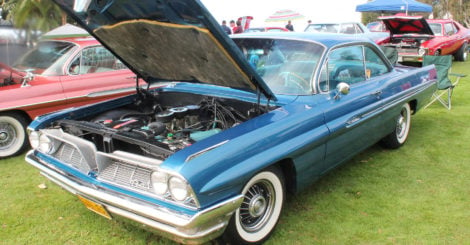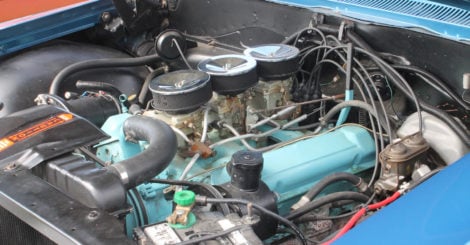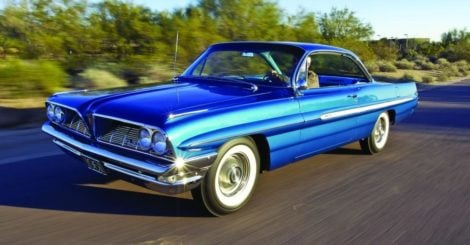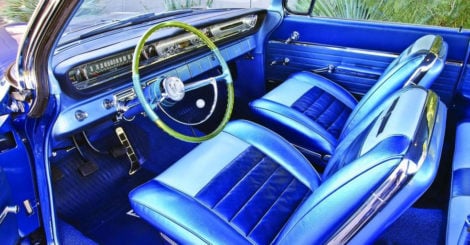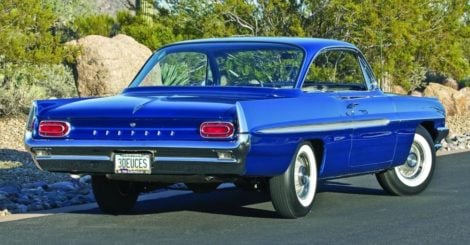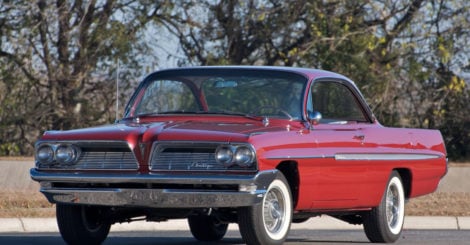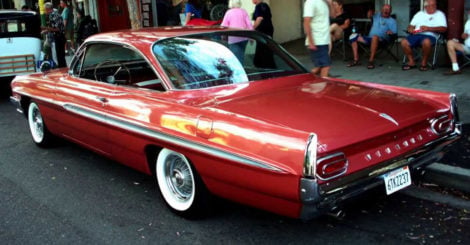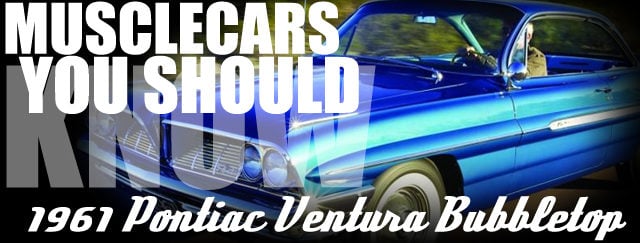 [1]Ask most horsepower aficionados when the original muscle car era got underway and you’ll likely hear that 1964 is understood to be the origin of the species, with Pontiac’s new GTO bringing big horsepower and a four-speed manual gearbox to their intermediate bodied coupes. This stood in contrast to the design strategies of the past, where automakers’ most potent hardware had been reserved for the biggest, and most luxurious vehicles in their lineup.
[1]Ask most horsepower aficionados when the original muscle car era got underway and you’ll likely hear that 1964 is understood to be the origin of the species, with Pontiac’s new GTO bringing big horsepower and a four-speed manual gearbox to their intermediate bodied coupes. This stood in contrast to the design strategies of the past, where automakers’ most potent hardware had been reserved for the biggest, and most luxurious vehicles in their lineup.
With the GTO, Pontiac instead looked to page one of the high performance handbook, leveraging the all-important power-to-weight ratio by pairing a big motor with a smaller vehicle that wasn’t saddled with an array of superfluous content that performance enthusiasts weren’t interested in. However, it certainly wasn’t the first time that this high performance strategy had been brought to production – not even by Pontiac specifically.
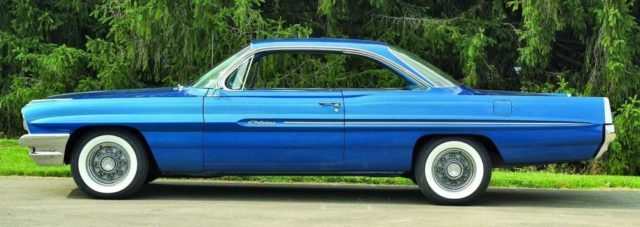 [2]
[2]We tend to think of the ’64 Pontiac GTO as the model that would usher in the muscle car era, but the reality is that Pontiac was putting that potent 389-cube V8 into lightened, intermediate bodied coupes and backing it with a four-speed manual transmission years before the Goat ever landed in Pontiac showrooms. This ’61 Ventura Bubbletop is something of a proto-muscle car, containing all the ingredients that would define the segment, including a robust, factory-backed aftermarket of performance parts that came directly from Pontiac’s racing efforts. Image: Hemmings
A few years prior, a one-year offering from GM’s performance-minded brand merged big block power and a capable transmission with a svelte chassis in the form of the 1961 Pontiac Ventura Bubbletop. It’s a fairly rare bird that is often overlooked in the annals of muscle car history, but has every right to be acknowledged in the sentence as cars like the GTO, the Chevy Malibu SS, and other trailblazing factory hot rods that ushered in the democratization of horsepower.
The Ventura Goes High Performance
Hitting the streets several years before high performance offerings like the GTO and Mustang, it might seem like the Ventura Bubbletop was some kind of brief factory experiment before it was decided to move into youth oriented vehicles in earnest. But, the reality is that the progression toward both the ’61 Ventura Bubbletop and the ’64 GTO had begun in the decade prior.
The motor that would define Pontiac performance during the mid-1960s actually dates back to the late 50s, when the company decided to bump their 370-cube V8's displacement to 389ci. Its iconic Tri-Power triple-carb setup was available as early as 1959, along with other performance upgrades from Pontiac's Super Duty program. By the time it hit showrooms in 1961, the Ventura Bubbletop could be had with no less than seven different versions of that 389, ranging from a 215hp two-barrel to the top-spec, 348 horsepower Tri-Power mill. Around the same time Ace Wilson's Royal Pontiac dealership in Royal Oak, Michigan, emerged as a semi-official source for factory-backed performance tuning, offering would-be owners a reliable source for Pontiac performance parts to take the Ventura's capability even further.
Pontiac followed in step with General Motors’ stablemate Chevrolet in many ways at the time, adding a V8 powerplant to its option sheets in 1955 and mechanical fuel injection for the 1957 model year, while tri-power and dual quad carburetor configurations were in production long before the GTO was conceived. By 1959 Pontiac had punched out its 370ci V8 to 389 cubes, setting the stage for the following decade’s celebration of Poncho horsepower. Customers could pair the motor with a Tri-Power setup that was good for 345 horsepower right out of the gate, while dealer-installed Super Duty upgrades could push output up to 363 horsepower.
Along with the formidable hardware available, the Ventura Bubbletop also helped forge the template for the muscle car era with its purposeful sense of style, adopting a more sporty aesthetic than the stately look of the previous year. That made sense considering the fact that this car rode on a three-inch shorter wheelbase than the previous year's model, which saved some 200 pounds in the process. But the Ventura was also far from bare bones, adorned with no shortage of chrome both inside and out, as well as upscale interior appointments like the tri-color upholstery. Images: Hemmings
While this potential mill bode well for Pontiac performance, upon its introduction it was still tasked with motivating the company’s big, heavy chassis. But that changed for the 1961 model year when Pontiac decided to shorten the Ventura’s wheelbase 122 inches to 119. The body itself was chopped by four inches as well, and the reduction of mass would cut more than 200 pounds from the Ventura’s curb weight.
Coupled with Pontiac’s wide array of available performance hardware, the Ventura was suddenly a very capable machine that could be further enhanced with light-weight aluminum components from the company’s racing program, and a Borg-Warner four-speed manual was now an optional production item rather than a special order piece as it had been in the past. And while the optional 389 tri-power configuration was undoubtedly the headliner with its 348 horsepower, the Pontiac big block could be had in no less than seven different flavors, offering 215, 230, 235, 267, 283, 287, 303, 318, 333 and the aforementioned 348 horsepower depending on carburetor, compression ratio, and transmission options chosen. In its most performance-focused configuration, it was said to be capable of hitting 60 mph from rest 8.2 seconds on its way to a quarter mile time of 15.5 at 93 miles per hour according to instrumented testing conducted by Motor Trend.
1961 would also re-introduce the Pontiac split grille after a one-year hiatus, a stylistic trait that would help define the face of the company's cars well into the 1970s. Adding to the Ventura's distinctive styling was the convex C-pillar that earned it the Bubbletop name, as well as the optional 8-lug aluminum wheels. First introduced in 1960 and exclusive to Pontiac, these Kelsey-Hayes wheels were cast integrally with the brake drum to provide improved braking capability, adding a measure of function to go along with the form. Images: Mecum, Gearheads
But beyond its sheer performance potential, the ’61 Ventura Bubbletop had style, showing a deliberate nod toward an emerging market of enthusiast buyers who were more interested in the cool factor than they were in stately luxury. Along with the more purposeful look of the Ventura’s shortened wheelbase and body, the model also sported a unique roofline with a convex C-pillar that earned it the Bubbletop moniker. And although Pontiac had abandoned the split grille front end design they’d introduced in 1959 by the following year, a new interpretation of the styling cue returned for 1961 in the form of the Ventura’s twin-grille front end, a feature which would continue to be a hallmark of Pontiac design throughout the 60s and 70s.
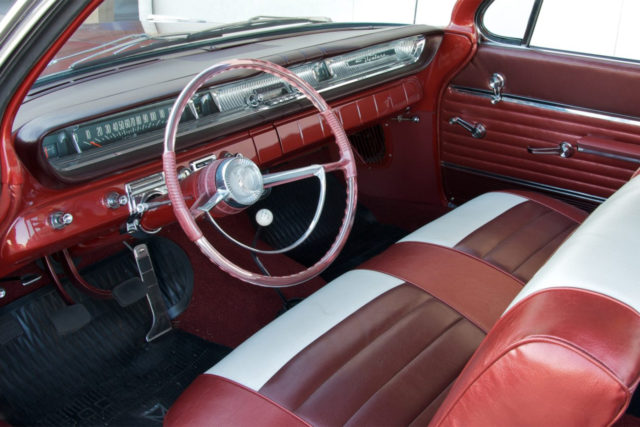 [10]
[10]The Ventura was equipped with Pontiac’s “Jeweltone Morrokide” upholstery, and could be had with a number of upscale accessories, including custom steering wheel and a Hurst shifter for the three-speed manual gearbox. Though far from austere, the style and design of the Ventura’s cabin showed a shift from the decadent cruiser of the previous year to a more purposeful layout that put more of an emphasis on the business of driving. Image: Mecum
Inside, Pontiac designers decided to give the Ventura some visual flare to go along with the performance. Though more subtle than the previous year, plenty of brightwork could be found throughout the car’s cabin, along with “Jeweltone Morrokide” tri-color upholstery, a custom steering wheel, and an electric clock. An optional, dealer-installed Hurst shifter was also available for the three-speed manual gearbox.
Legacy
Among the 44,727 two-door hardtops that Pontiac produced for the 1961 model year, only 13,297 were Venturas, making these high performance Pontiac coupes an uncommon sight today.
Adding to their rarity is Pontiac’s decision to merge the Ventura and Catalina models into one model and turning the Ventura name into a custom trim option for the Catalina from 1962 to 1965. In doing so, Pontiac had made the Ventura Bubbletop a one-year offering.
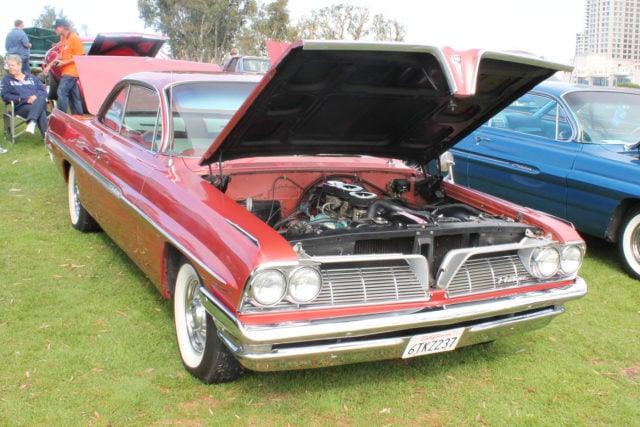 [11]
[11]The Ventura Bubbletop would prove to be a one year affair for Pontiac, as the company would turn the Ventura into a trim option for the Catalina the following year. As such, high performance iterations of this car are quite rare, and their value in the collector car market reflects both that rarity as well as GM fanatics’ penchant for anything with a bubbletop.
By 1965 the GTO had become the star of the Pontiac roster, offering affordable high performance to a young, performance-hungry automotive market that was chopping at the bit for such a vehicle. As a result the Ventura was, in some ways, dismissed by those buyers as being part of a by-gone era.
As with any GM bubbletop car, today the ’61 Ventura commands a healthy sum in the collector car market. For those in the know, its unique styling and the pivotal role it played in helping to usher in the muscle car craze that would follow makes the 1961 Pontiac Ventura Bubbletop highly sought after today.
